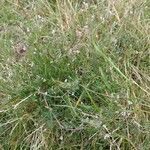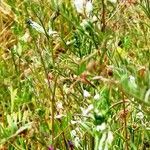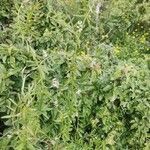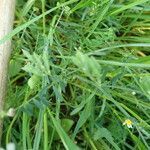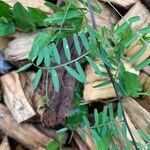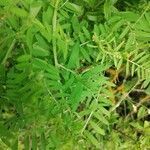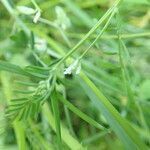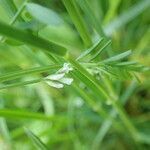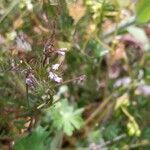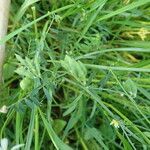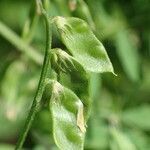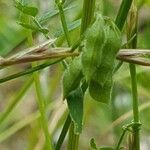Annual, herbaceous vine, up to 1 m long; sparingly pubescent, trichomes white. Leaves with rachis terminating in slender, ramified, filiform tendrils. Leaflets 4-16, thin, linear to narrowly elliptical, 5-20 x 1-4 mm, base tapering, apex emarginate or mucronulate. Stipules inconspicuous, sharply serrate to toothed. Inflorescences of elongate racemes with 2-6(8) closely spaced flowers. Flowers whitish blue. Calyx ± half as long as standard petal; teeth straight, attenuate, not gibbous at base. Petals: standard 2-5 mm long. Flowering time Sept.-Apr. Pod without stipe, 6-11 x 2.5-4.0 mm, oblong, brown to blackish, pubescent, short acuminate at both ends. Seeds mostly 2, spherical to sublenticular.
Slender scrambling annual; stem ± glabrous to sparsely hairy. Lvs sparsely to moderately hairy; tendrils usually branched; leaflets in c. 5-9 pairs, often alternate, linear to ovate-oblong, 5-18-(20) mm long; stipules entire or with 1-3, narrow, adaxial, basal lobes. Infl. ± = or < lvs, (2)-3-7-(9)-flowered. Peduncle much > fls. Peduncle 0-1-(2) mm long. Calyx not gibbous at base; calyx teeth ± equal, = or > tube. Corolla dull white or pale blue with purple spots on keel, c. 4 mm long; limb of standard < or ± = claw. Pod moderately to densely hairy, black, (1)-2-seeded, 8-11 mm long; seeds yellowish with purple blotches turning reddish brown; hilum ⅓ of circumference.
Herbs annual, 15-90(-120) cm tall. Stem climbing, slender, glabrescent. Leaves paripinnate; stipules semisagittate or lanceolate, margin 2-or 3-toothed at base; leaflets 4-8-paired, linear or narrowly oblong, 5-15 × 1-3 mm, glabrous; tendril branched. Raceme obviously shorter than leaf, densely 2-4(-7)-flowered at apex of rachis. Calyx campanulate. Corolla white to light purple, rarely pink, 2-4(-5) mm; standard elliptic, subequaling wings and longer than keel. Ovary sessile, densely rigidly hairy; ovules 2. Legume oblong-rhomboid, 5-10 × 2-5 mm, hirsute. Seeds 2, oblate-spheroid. Fl. Feb-Jun, fr. Feb-Aug. 2n = 12, 14.
An annual herb. It is slender and trailing or climbing. It grows about 60 cm high. There is a tendril at the end and it is branched. The leaves have stalks. The leaves are 2-5 cm long and divided into leaflets along the stalk. There are 5-10 pairs of leaflets. These have short stalks. They are 0.8-1.5 cm long and 0.1-0.3 cm wide. They are oblong. The base is rounded. The flowers are white or tinged with purple. The fruit is a pod which is oblong and has 2 seeds. The seeds are 2 mm across and brown. The pod is hairy.
Slender annual, climbing or decumbent, 3–6 dm; lfls usually 6–8 pairs, seldom fewer, linear to narrowly elliptic, 5–15 mm; peduncles 1–3 cm, with 3–8 whitish fls 3–4 mm; cal-lobes subulate, subequal, 1–1.5 mm, about equaling the tube; style not hairy, only the capitate stigma papillate; fr flattened, hirsute, 6–10 mm, normally 2-seeded; 2n=14. Native of Europe, intr. in fields, roadsides, and waste places throughout most of the U.S. and s. Can. May–Aug.
Annual climber, up to 1 m high; herbaceous. Stems slender, sprawling. Leaves 4-16-foliolate; leaflets linear, margins entire; rachis usually terminating in a branched tendril; stipules without nectary patches. Flowers: racemes elongate with 2-6(-8) closely spaced flowers, slightly shorter than subtending leaf; corolla up to 7 mm long, whitish blue; May-Aug. Pods oblong, flattened.
Like V. benghalensis but a sparsely hairy, trailing annual, up to 0.6 m tall, with small white or pale blue flowers, and with small pods with constrictions between seeds.
